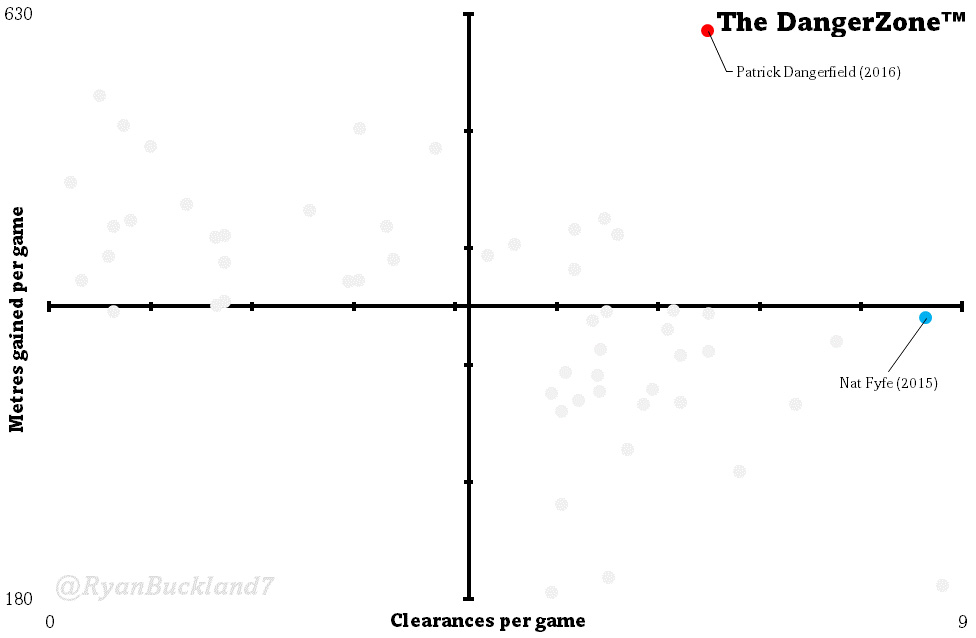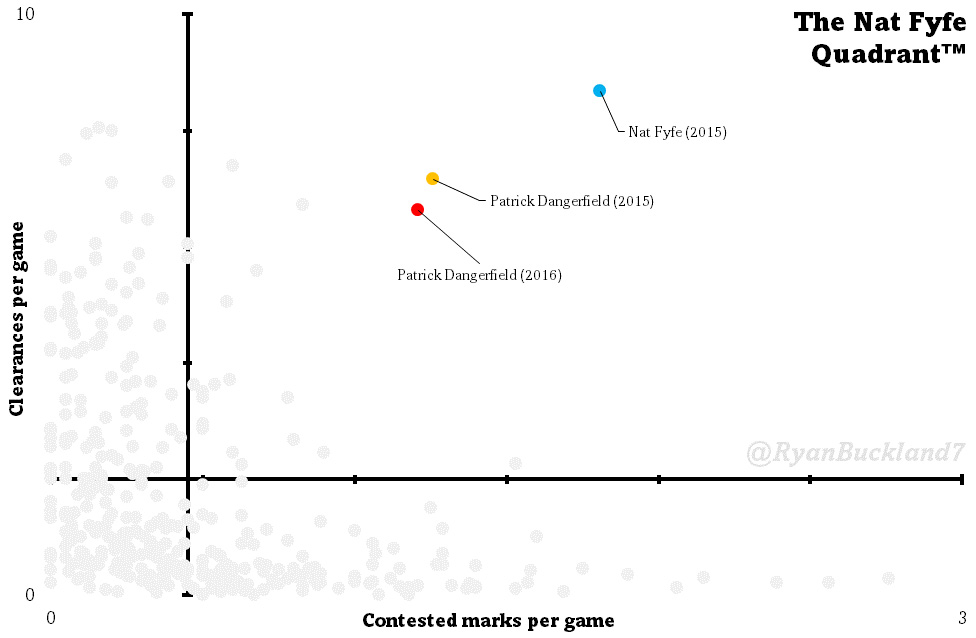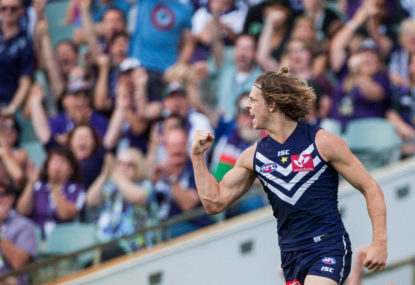This time last year, the talk of the town was whether Gold Coast’s Gary Ablett Jr would retake the number one crown from the new kid on the block, Nat Fyfe. Just 12 months on, the same question emerges, but with Fyfe the challenger.
Ablett’s fall from the top tier of talent was all but confirmed in the 2016 offseason. Already struggling to regain full fitness following his 2014 shoulder injury, which has limited him to 20 games over the past two seasons, Ablett requested a trade from the Suns to his former club Geelong.
His request was denied, but in the new AFL paradigm, denied merely means delayed.
More recently, he was left out of a new-look Gold Coast leadership group after handing the captaincy over at the end of last season. The players vote on this group. They decided Ablett was no longer required. For a player whose leadership has been questioned throughout his tenure up north, the actions of the playing group speak volumes.
It’s harsh, but entering his seventh year as the Suns’ high-profile initial recruit, Ablett has become just another player. The return of the king turned out to be a flop.
Return of the King, Part 2
For Fremantle’s Nat Fyfe, the stakes are significantly higher. His 2017 season looms as large as any individual in the game.
The 2015 Brownlow medallist played four and a half games in 2016, with a recurrence of his fractured left fibula – surgically repaired after a stress fracture gave way to a break in 2015’s preliminary final – leading to a long layoff.
In his absence, his team floundered. Fremantle’s 2016 season lurched from dither to disaster. A 17-win campaign (albeit one that was more in keeping with 15 wins) gave way to four-win season, with the Dockers avoiding the wooden spoon by a game as some percentage. It was the worst sophomore season for a reigning minor premier in VFL/AFL history.
Having Fyfe would have helped Fremantle, but he was not the difference between a 12-win finals campaign and a four-win shitshow.
So, like the Suns, the Dockers have retooled, delisting some veterans who still had petrol in their tanks, and replacing them with bit parts from teams across the competition.
Out of interest, all four of Fremantle’s new additions (Joel Hamling, Bradley Hill, Shane Kersten and Cam McCarthy) fall into a demographic that suits Fyfe’s career arc. More on that as the pre-season progresses.
He’s back now, ready to play a central role in reviving the Fremantle Dockers. But for Fyfe himself, it is set to be a busy year.
First and foremost, Fyfe needs to get back to being Fyfe. Pre-injury, between Round 1 and Round 17 of 2015, the eventual Brownlow medallist averaged 30 disposals, 18 contested possessions and 8.5 clearances per game. Those numbers translated into a lazy 31 Brownlow votes.
From then (Round 20 and 21 and then in Fremantle’s two 2015 finals, and Rounds 1 through 4.5), his counting stats have fallen from those stratospheric heights to something more earthly: 24 touches, 15 contested possessions and seven clearances.
He looks in remarkable nick. Seriously, it’s nigh-on comical. But that counts for nought if his surgically repaired leg fails his 90-plus kilogram frame once again.
Second, 2017 is a contract year for Fremantle’s No.7. But it is no ordinary contract year: Fyfe is a restricted free agent. He is arguably the biggest player to hit free agency since the mechanism was introduced in 2012, and there has already been a flurry of takes on his future.
Fyfe signed what is technically his fourth contract in 2014 (having been drafted in 2009, signing a one-year extension thereafter, and signing a third deal in 2011). At the time, he was beginning to flourish, averaging 27 disposals and a goal a game in a Fremantle team that was at its apex. He obviously went to another level in 2015, and could have been expected to maintain his excellent play thereafter. His is a prized signature.
Right now, you’d be foolish to think he’s leaving. Fyfe is a West Australian, the clear Fremantle alpha male, and the Dockers will have planned every single decision around Fyfe’s 2017 contract year meticulously. They will fill every cell in the heritage-listed Fremantle Prison with $100 notes and give Fyfe the master key. A seven-year deal, carrying him through to the end of the 2025 season? Don’t be shocked.
Equally, Fyfe may prefer a more short-term deal to take him through to unrestricted free agency in the 2019 off-season. That would give Fremantle enough time to show they’re on the right path, and mean Fyfe retains his optionality should that not materialise.
Regardless, until he signs on the figurative dotted line, Fyfe’s contract status will be a story. We will keep close tabs on it throughout the year, as we did during Patrick Dangerfield’s pre-agency season.
Speaking of which, the third item on Fyfe’s 2017 to do list is his looming battle with Patrick Dangerfield for the title of the Best Player in the AFL.
We can all agree that these are the two best players in the game, right? Everyone has a different take on the top ten – as The Roar’s AFL stable will show in a few week’s time with our annual top 50 – but sitting atop the pyramid are these two colossuses. Fyfe and Dangerfield are the best.

Batman versus Superman, but with footballs
There are few superlatives left to describe Dangerfield’s 2016 season. He put his new team on his back and carried them to the second-last game of the year, with his power running (both into and out of packs) and penetrating kick adding a new string to the Cats’ bow.
A record 35-vote performance in the Brownlow medal, there is nothing else Dangerfield could have done to improve his team on the field.
Dangerfield wrested the Best Player Championship Belt from Fyfe. That was through no fault of Fyfe, he wasn’t around to defend it. But what if he had been? Would a hypothetical 2016 Nat Fyfe have produced a better season than 2016 Dangerfield? There’s no way of knowing.
But there is a way to at least partially compare the two, using a couple of tools I’ve bought up previously. Remember the DangerZone and the Nat Fyfe Quadrant?
Let’s see where both parties’ seasons fall on each other’s specially-designed matrices to measure their unique football attributes.
First, the DangerZone.

Dangerfield is on his own planet in this chart, which compares clearances and metres gained for the top 30 players in each respective category. As we discussed last year, there are three groups on this chart: the metres gained guys, the clearance guys, and the bit-of-everything guys (which is the smallest group). Dangerfield is the only player who gathered a tonne of clearances and gained a bucket load of metres for his team in 2016.
Fyfe’s 2015 season, which saw him average 8.7 clearances and 395 metres gained per game, puts him in the clearance monster category – albeit with a forward drive that would place him around the middle of this sample. In this respect, Fyfe’s 2015 season was an amped up version of an inside animal.
How about Dangerfield’s 2016 season on the 2015 Nat Fyfe Quadrant?

There were 21 players who met the above average in contested marks/above average in clearances mark in 2015, but no one came close to Fyfe’s dominance of the ground and the air. Fyfe finished seventh in contested marks per game, on 1.8, with six hulking key forwards ahead of him. Early in that year, Fyfe was leading all comers, averaging more than 2.5 aerial contest wins a game – as a midfielder.
One of those players was Dangerfield, who won 7.1 clearances and 1.3 contested marks per game in his final year with the Adelaide Crows. He was the only player in the league to get close to Fyfe, but he was still around 50 per cent below the Brownlow medallist’s mark.
In summary, they’re both freakishly good in their own way. Although both clear leaders in their particular, unique ways of doing business, both Dangerfield and Fyfe are among the closest avatars for each other. Both enter the 2017 AFL season in their respective primes, Dangerfield in his 26-year-old season and Fyfe his 25-year-old season.
Can Fyfe retake his crown?
It has been 87 weeks since both Dangerfield and Fyfe graced the same football field. The Saturday night encounter between Adelaide and Fremantle was a dreary affair, with sopping rain sprinkling over the field for the full 120 minutes.
Fremantle were 8-0 and flying atop the ladder, where Adelaide were a game ahead of 0.500 in sixth place. It was a close finish in the end, and a tense scrap for the entirety. But that is not what made this game memorable.
Dangerfield and Fyfe were direct opponents for 78 minutes of the game, according to Champion Data. For 60 per cent of the game, the two best players in the league threw down. It was a genuine Superman vs Batman-style battle, with both champions free to power their teams.
In the aftermath, it was clear some kind of glorious game of chicken had emerged.
“We acknowledged Dangerfield was getting a fair bit and we thought we’ll just let it sit,” said Fremantle coach Ross Lyon.
“Call me a weirdo, but I think we have to protect the look of the game,” the late Phil Walsh conveyed. “I want to win, but I also think the fans want to see those great battles.”
It was a battle, but in the same way that you might face off one-on-one in laser tag. Yeah, you’re shooting, but the hits you’re taking don’t stop you from firing right back. It was the stuff of video games.
Dangerfield had 39 touches to Fyfe’s 40. Dangerfield gained 582 metres to Fyfe’s 958. Dangerfield won 29 contested possessions to Fyfe’s 26, and nine clearances to Fyfe’s 14. Both took three contested marks – a football miracle given the conditions – and kicked a goal.
The winner in the eyes of the umpires was Fyfe, who took the three Brownlow votes over Dangerfield’s two. Personally I agree, Fyfe’s game was more influential overall, particularly in the conditions which meant forward progress was the goal. Really, everyone in the AFL diaspora won.
We haven’t seen the return leg yet. The Crows and Dockers didn’t play again in 2015, and Fyfe missed Fremantle’s lone hit-out against the Cats in 2016 due to injury. Fortunately, we don’t have to wait long: Fremantle host Geelong on Sunday, March 26, as the after-dinner mint to a delectable Round 1 football feast.
Fingers crossed, the Dockers and Cats play once more in 2017, in Round 14. They will be two opportunities for Fyfe to catch his nemesis.
As much as we should all be excited to watch the high-flying Fyfe return to the field, we should be excited to see whether Dangerfield can back up his remarkable 2017.
Dangerfield’s Brownlow win was the largest single-season vote accumulation in the history of the medal. His 32 disposals (second in the league), 16 contested possessions (fourth), 620 metres gained (first), 6.8 clearances (fourth) combined to create a historically legendary individual season. Dangerfield’s marks for disposals, metres gained and clearances were all career highs, as were his mark, goal assist and score involvement tallies.
Dangerfield would have wrested the title from Fyfe regardless of the number of games Fremantle’s centrepiece was fit for last season.
But can he back it up? One would expect him to come back to the pack, even just a little, given the extraordinary nature of his 2016. Geelong will still be thereabouts the top four, but the extent to which they can return to the top two may well hinge on another superhuman season from their superstar.
In many ways, Dangerfield will decide who wears the Best Player Championship Belt.
At their respective bests, Dangerfield and Fyfe are as close to match winners as you can hope to see in a game where there are 36 players on the field at a time. The former will beat you to a pulp with acceleration and front-on power, where the latter will gladly burst out of a congested pack with the ball enveloped in his extra-terrestrial paws. Dangerfield’s straight-line speed belies a player with his build, as do Fyfe’s aerial abilities.
Both in their primes, Dangerfield and Fyfe will have outstanding seasons. I am an outed Fyfe obsessive, and I can see him returning to better than his best from 2015.
Sorry Paddy, your reign atop the league will prove a short one.
































































































